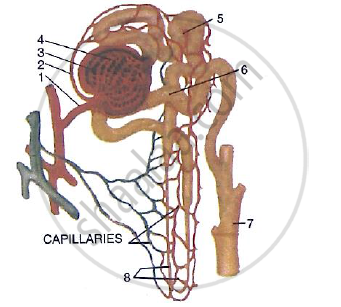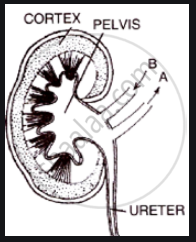Advertisements
Advertisements
Question
Differentiate between
excretion and transpiration
Solution
| Excretion | Transpiration | ||
| 1 | It is the process of removing or getting rid of waste matter from the body. | 1 | It is the process of losing excess water from aerial plant parts in the form of water vapour. |
| 2 | Excretion rate is independent of the time of the day. | 2 | The rate of transpiration is more during the day. |
| 3 | All living beings have special organs called excretory organs to get rid of their harmful wastes. | 3 | Plants lose water through stomata and lenticels. |
| 4 | It occurs both in plants and animals. | 4 | It occurs only in plants. |
APPEARS IN
RELATED QUESTIONS
Name the Following
The organ which produces urea.
What are the methods used by plants to get rid of their waste products?
Define the following term:
Osmoregulation
The following diagram represents a mammalian kidney tubule (nephron) and its blood supply.

Parts indicated by the guidelines 1 to 8 are as follows:
1. Afferent arteriole from renal artery
2. efferent arteriole
3. Bowman’s capsule
4. Glomerulus;
5. Proximal convoluted tubule with blood capillaries;
6. Distal convoluted tubule with blood capillaries;
7. collecting tubule;
8. U-shaped loop of Henle
Study the diagram and answer the question that follow:
Where does ultrafiltration take place?
Given below is a highly simplified diagram of the human kidney cut open longitudinally. Answer the question that follow:
Why does the cortex of the kidney show a dotted appearance?

Choose the correct option.
Specific gravity of urine would _______ if level of ADH increases.
Choose the correct option.
What is micturition?
The mode of excretion of nitrogenous wastes like ammonia which takes place by simple diffusion is called ______.
Plants use completely different process for excretion as compared to animals. Which one of the following processes is NOT followed by plants for excretion?
Name the following;
Three nitrogenous wastes of our body.
